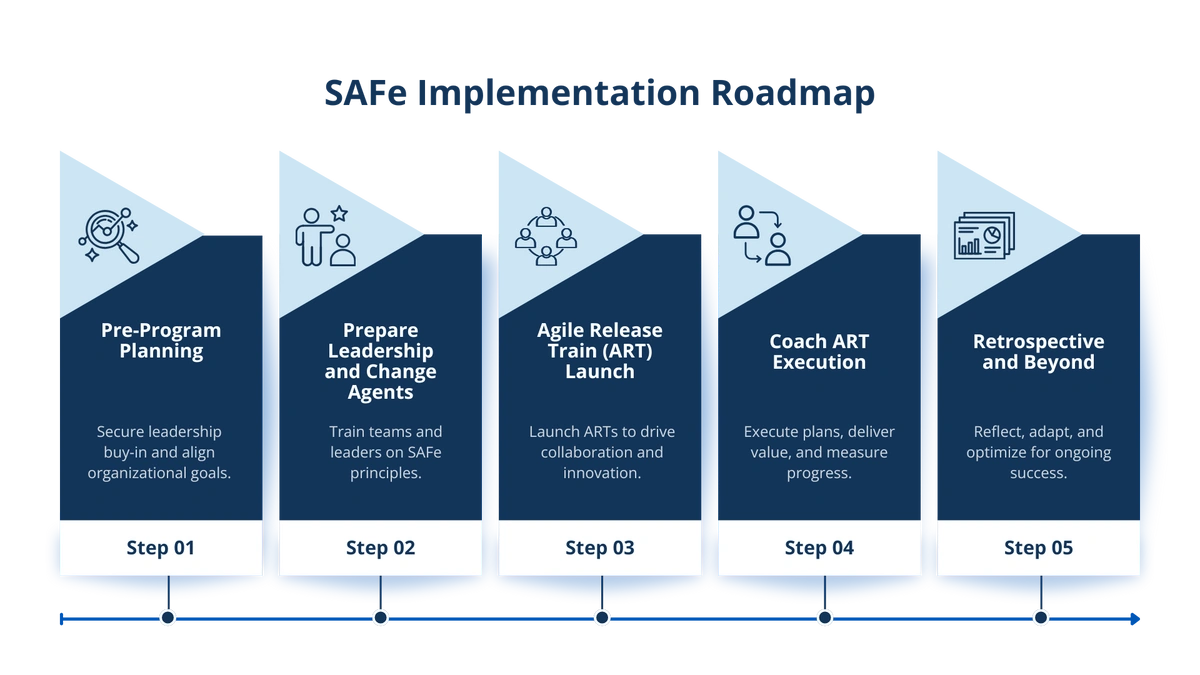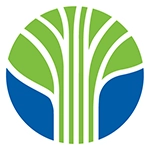Scaling Agile across an enterprise — a true Agile Transformation — is a complex undertaking, demanding structured change, strong leadership, and a clear strategy. The Scaled Agile Framework (SAFe) provides a proven system for organizations that seek alignment, collaboration, and continuous improvement at every level. For professionals seeking career advancement, global mobility, and skill diversification, mastering these principles is essential. Learning Tree’s SAFe Implementation outlines a practical five-step roadmap, distilled from work with Fortune 500 companies, government agencies, and leading Agile teams.
Below, explore each step, illustrated by real-world examples and actionable advice designed to empower your SAFe journey and position you at the forefront of organizational change.

Step 1: Pre-Program Planning
Every successful SAFe Implementation begins with a comprehensive understanding of your organization’s current Agile maturity. This diagnostic phase is critical, laying the foundation for a customized implementation plan that aligns with your unique goals and needs—key for global organizations and professionals aiming to demonstrate expertise across markets. Learning Tree’s experienced SAFe Program Consultants (SPCs) and dedicated customer service teams conduct individual skill assessments and an Enterprise Agile Maturity Assessment, ensuring your Agile Transformation is both data-driven and targeted.
A core component in this stage is securing buy-in from business leaders and executive teams. As Marguerite Bryan, SPCT, emphasizes in a recent webinar, the path to successful SAFe adoption requires moving beyond a technology-centric message and addressing the priorities and language of the business itself. Practitioners must frame objectives in terms of the value they deliver to the organization, rather than technical achievements. This approach begins by understanding the specific pain points and considerations of business leaders, then presenting SAFe as a direct response to these challenges. Practicing empathy—truly seeking to understand the business perspective—enables you to communicate in ways that resonate, laying the groundwork for deep alignment.
- Conduct individual skills assessments: Uncover capability gaps to tailor learning and development—crucial for those aiming to expand their credentials for international roles.
- Facilitate an Enterprise Agile Maturity Assessment: Establish a baseline, mapping your position on the global Agile landscape.
- Host a program kick-off event: Gather Agile Release Train (ART) members, business owners, and support teams to align vision, goals, and roles—creating momentum for a smooth transition. Use this forum to engage business stakeholders with value-centric objectives that address both their needs and strategic priorities.
Example: One global company minimized transformation roadblocks by bringing together ART members from across regions for a program kick-off. Aligning key stakeholders at the outset—through business-focused conversations that highlighted organizational value—built a unified vision and accelerated their transition, supporting their international growth strategy.
Get Business Buy in! Scaled Agile Framework Implementation.
Step 2: Prepare Leadership and Change Agents
Enterprise agility thrives on leaders and change agents who fully understand Lean-Agile principles. Preparing executives, managers, and pivotal roles is a cornerstone for SAFe Implementation — especially for organizations seeking global scale and for individuals pursuing leadership roles or enhanced credentials. Targeted training, such as Leading SAFe, supports the creation of a Lean-Agile Center of Excellence (LACE). This dedicated hub serves as the foundation for sustained agility and best practices.
- Provide Leading SAFe training for business leaders, empowering them to guide teams and model effective transformation.
- For those navigating public sector projects, consider the specialized SAFe for Government Training, which addresses unique challenges faced in government environments.
- Pursue SAFe Lean Portfolio Management Training to equip your leaders and LACE members with critical skills in prioritizing and managing portfolios at scale.
- Establish a Lean-Agile Center of Excellence (LACE). This center coaches, mentors, and sustains momentum — a vital asset for large, distributed, or international organizations.
- Launch workshops to prepare change agents, ensuring they are ready to champion the Scaled Agile Framework (SAFe) values across every department.
Example: A federal agency created its LACE with Learning Tree’s help, sparking a cultural shift that enhanced collaboration and supported cross-border project success. Leadership alignment paved the way for continuous value delivery and broader career opportunities for involved professionals.
Step 3: Agile Release Train (ART) Launch
Launching your first Agile Release Train (ART) is a critical milestone in SAFe implementation, turning theory into actionable value delivery. ARTs align teams around customer value streams, enabling continuous, incremental value creation. Success in this phase depends on fostering innovation and experimentation through practices like design thinking and set-based design. Innovation and Planning (IP) iterations offer dedicated time for learning, prototyping, and exploration, cultivating adaptability and continuous improvement.
Key steps for a successful ART launch include facilitating Value Stream Identification workshops to map value delivery, setting up a strong cadence for Program Increment (PI) ceremonies, and providing professional development for roles like Release Train Engineer, Product Owner, Scrum Master, and Agile Teams. Training in SAFe principles is essential for leaders seeking to drive transformation.
Recommended courses include SAFe Scrum Master Training, SAFe Product Owner/Product Manager, and SAFe Release Train Engineer (RTE) Training to build expertise and readiness.
Embedding SAFe Program Consultants (SPCs) ensures hands-on support for teams throughout the Program Increment cycle. SPCs lead key ceremonies, coach teams to maintain productivity, and facilitate Inspect and Adapt workshops to drive continuous improvement. Advanced training options, like SAFe Advanced Scrum Master Certification and SAFe DevOps Training, further strengthen team agility and delivery pipelines.
Real-world examples highlight the impact of these strategies. Multinational firms using Value Stream Identification workshops and embedded SPCs have improved collaboration, reduced feedback cycles, and elevated delivery standards. Integrating SAFe training and coaching into your transformation journey lays the groundwork for lasting growth and enhanced global competitiveness.
SAFe Product Innovation: Unlocking Agile Success with Lean Practices.
Step 4: Coach ART Execution
Successfully implementing SAFe (Scaled Agile Framework) requires more than just knowledge of the framework—it demands ongoing support, alignment, and collaboration across teams. Customized enterprise training programs can play a critical role in helping organizations navigate this transformation effectively, providing tailored coaching and mentoring to address the unique challenges of each team.
Tailored coaching focuses on embedding SAFe practices into daily workflows while fostering team alignment and encouraging continuous improvement.
Key examples of customized coaching include:
- Embedded Coaching Days: On-the-ground support to help teams apply SAFe principles in real-time.
- Inspect and Adapt Workshops: Structured sessions to evaluate progress and identify opportunities for improvement.
- Iteration Planning: Facilitating clear planning to define goals and priorities for each sprint.
- Backlog Refinement: Helping teams maintain a well-organized and actionable backlog.
- Daily Stand-Ups: Guiding teams in effective communication and collaboration during regular check-ins.
- Iteration Reviews: Ensuring teams reflect on deliverables and gather feedback from stakeholders.
- Retrospectives: Encouraging honest evaluation and identifying changes to improve future performance.
- Scrum-of-Scrums: Supporting coordination across multiple teams working toward shared objectives.
This comprehensive approach not only helps organizations deliver incremental value but also promotes alignment, builds stronger collaboration, and fosters a culture of continuous improvement. By focusing on these practices, teams can gain greater predictability, improve outcomes, and ensure long-term success in their SAFe transformation journey.
Step 5: Retrospective and Beyond
A successful SAFe Implementation goes beyond the initial rollout. By fostering a culture of continuous improvement, regular retrospection, and ongoing skill development, both organizations and professionals can stay agile, adaptable, and prepared to seize new opportunities—whether locally or globally. Post-PI assessments and retrospectives connect global teams around practical lessons and next steps for expansion and sustained growth.
To further your expertise and support continuous improvement, consider targeted training such as the SAFe for Government Micro-Credential: Roles & Responsibilities, SAFe Lean Portfolio Management Training, or SAFe Agile Product Management Training. These courses help professionals sharpen their skills, lead with confidence, and navigate the evolving demands of global Agile environments.
- Deliver post-PI skills and maturity assessments to identify strengths and development opportunities — supporting ongoing skill diversification for career growth.
- Facilitate in-depth retrospectives with ART members and business leaders to reflect on lessons learned and optimize future Agile Release Train cycles.
- Provide advanced, targeted training to address evolving needs. Explore these courses to gain the specialized expertise required for transformation at scale.
Example: After a successful first PI, a global services leader utilized the expertise of the Release Train Engineer (RTE) to identify further growth opportunities, expanding their ART model internationally and unlocking new mobility options for PMs and agile professionals.
Common Challenges and Key Considerations
- Leadership alignment is foundational — engaged leaders drive agile success and empower teams to embrace the Scaled Agile Framework fully.
- Robust training and coaching build confidence and skill, equipping PMs and teams to lead Agile in any market.
- Data-driven assessments identify the exact skills needed for transformation and global mobility within complex organizations.
- Continuous feedback sustains momentum and adapts your SAFe Implementation to fast-changing business environments.
Your Transformation Starts Here
A successful SAFe Implementation is built step by step, empowering both organizations and individuals to deliver value at scale, advance their careers, and thrive in global contexts. Professionals who master each phase position themselves for international opportunities, rapid advancement, and skill diversification in a competitive landscape.
To accelerate your journey and achieve the benefits of the Scaled Agile Framework, connect with Learning Tree’s expert coaches. Whether you are taking the first step or fine-tuning your approach, our team can help you align your strategy, maximize outcomes, and secure your place as a leader in enterprise agility.


